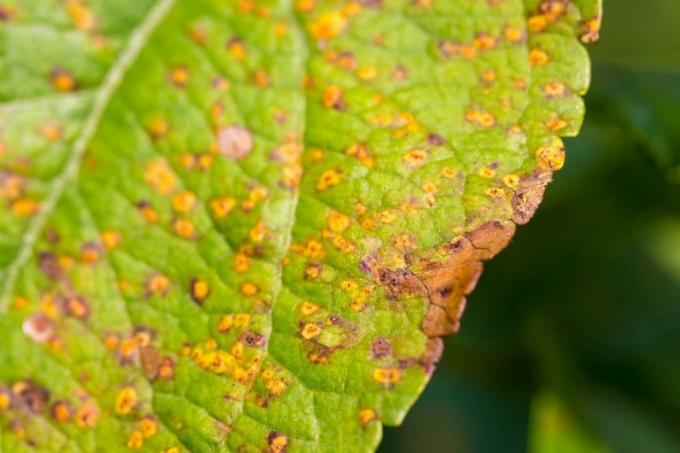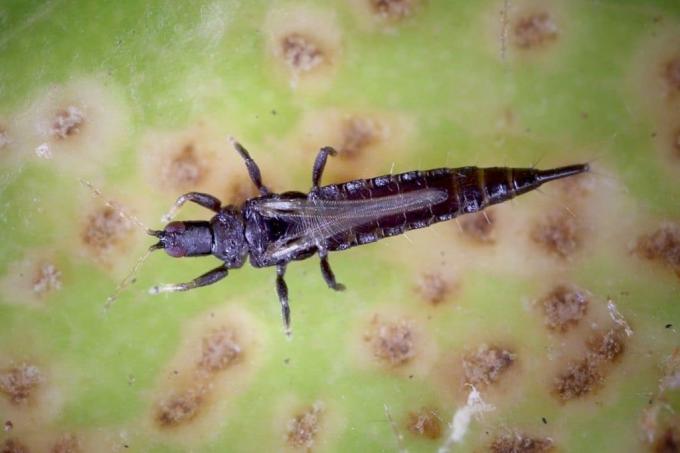
table of contents
- Avoid care mistakes
- Rubber tree diseases
- lice
- Mites
- Other pests
- frequently asked Questions
Rubber trees are very popular as ornamental plants in this country. They are quite robust and extremely easy to care for. The rubber tree is only recommended for beginners. However, it is sometimes not spared from diseases and pests. We'll show you the most common rubber tree diseases and how to fight them.
In a nutshell
- Care errors mostly cause disease and pest infestation
- Waterlogging causes root rot
- Leaf spot disease is contagious
- Spider mites, mealybugs and the like are common
Avoid care mistakes
Mistakes in care and a wrong location can generally weaken the rubber tree (Ficus elastica). Then the plants are susceptible to diseases and pests. An infestation by diseases and pests can be observed, especially if the indoor climate is too dry and warm during the heating period in winter. In addition, rubber tree disease can also occur if the location is incorrect. Yellow and brown leaves are then not uncommon. The most common causes can be:
- too cold location
- Drafts
- no air circulation
- too low humidity
- Waterlogging
- incorrect fertilization
- too cold irrigation water
Below is a small list of common diseases and pests.
Rubber tree diseases
Leaf spot disease
This disease is not just a rubber tree disease, it can affect other plants as well. This is a fungal infection that mainly affects weakened rubber trees. In the worst case, however, this disease can lead to the death of the rubber tree. Symptoms are
- yellowish to light brown, black or reddish spots on the leaf blade
- Shape oval to rounded
- in the middle black point (mushroom fruit body)
- Stains are dry, brittle and hard
- very rapid spread

Combating rubber tree disease
- isolate rubber tree because of the risk of infection
- cut off affected leaves
- then spray with special fungicides
- Rethink care errors and location
Chlorosis
It is a magnesium deficiency. The plant can no longer produce leaf green (chlorophyll). The photosynthesis metabolism is disturbed as a result. Chlorosis is also known as jaundice or bleaching. Signs are
- poor growth
- yellow leaves
- dark green leaf veins
- Leaves dry from the outside in (necrosis)
- finally leaf fall

Combating rubber tree disease
- Administration of a special magnesium fertilizer based on magnesium sulfate
- also known as Epsom salt
- long-term application of complete fertilizer
Root rot
Constant waterlogging can result in root rot. The roots start to rot and eventually suffocate. As a result, the rubber tree can no longer be supplied with water and nutrients. If there is no help, it dies. Symptoms are
- yellow and finally brown, drooping leaves
- discolored leaf areas are moist and soft
Combating rubber tree disease
- Repot in dry, fresh substrate
- Rinse the root ball under lukewarm water
- Cut off rotten roots
- Apply ash or charcoal powder to cut surfaces
- Let dry 2 to 3 days before potting
- Pot must have drainage hole and drainage layer
Note: To prevent discoloration of the leaves, the rubber tree should be provided with liquid fertilizer every four to six weeks.
lice
Aphids (Aphidoidea)
These pests suck out the sap and secrete so-called honeydew. They can be found on the shoots and the underside of the leaves. But the rubber tree dies without treatment. Aphids are 3 to 7 mm in size, green, black, yellow or brown and have a proboscis.
The first signs of an infestation are
- rolled up leaves
- yellow leaf discoloration
- floury topping on leaves
- Leaf fall
- Presence of ants

Combat
- if the infestation is low, simply shower off
- Don't forget the underside of the leaves
- Use of spray solutions based on neem or rapeseed oil
- Use of beneficial organisms such as predatory mites and parasitic wasps
Scale insects (Coccoidae)
These pests also suck up the sap and weaken the plants. However, combating them and the gum tree disease related to it can be persistent. Scale insects are recognizable
- sticky deposits on leaves (honeydew)
- on the underside of the leaf, shoots and small pox-like growths in the shoot axils
Combat
- Pick up lice by hand
- alternatively brush with a toothbrush
- Wipe the leaves with a mixture of 10 ml of cooking oil, 1 l of water and a few drops of washing-up liquid
- Use of predatory mites, parasitic wasps or ladybird larvae
Note: Dust on the leaves clogs pores, making breathing difficult. Therefore, wipe or shower regularly with a damp, soft cloth.
Mealybugs (Pseudococcidae)
They are also known as mealybugs or root lice. The hairy lice, which are 0.5 millimeters in size, mainly suckle on leaves, stems and roots. In addition, they secrete a greasy substance that affects the vitality and growth of the rubber tree. The first signs are yellow, curled up or dried up leaves and honeydew.

Combat
- Isolate plants
- place in a cool and bright place
- Use a spray mixture of 1 l water, 15 ml spirit, 15 ml paraffin oil or curd soap
- Use for 2 to 3 days
- repot for root lice
- Use of parasitic wasps, Australian ladybirds, lacewings
Note: A Leaf loss is usually the result of an incorrect location, incorrect fertilization, incorrect watering behavior, too small a pot or pest infestation and a sign of gum tree disease.
Mites
Spider mites (Tetranychidae)
They often occur when the air is too dry and the temperature is too warm, or the rubber trees have been too dry for a long time. The first signs of an infestation are
- fine webs on leaf and branch forks, as well as the underside of the leaf
- scattered blobs on the leaves
- Leaf discoloration from gray to brown

Combat
- shower off with a powerful, lukewarm jet of water
- then wrap the plant with transparent plastic film
- leave it like this for a few days
- Spider mites die when the humidity rises
- Use of predatory mites
- Check location
- Spray regularly with water as a preventive measure
Soft skin mites (Tarsonemidae)
These pests are 0.2 millimeters in size and white to yellowish in color. They too suck the sap from the leaves and shoots. The first signs can be
- small growth
- rolled up leaf margin
- Deformities, cripples, brown discoloration of the shoot tips and leaves
- brown deposits and cork on the underside of the leaf
- Leaf veins stay green
Combat
- Spray animals with agents based on rapeseed oil
- Cutting back the plants
- Use of predatory mites
- Disposal of the plant in the event of severe infestation
Other pests
Red spider (Panonychus ulmi)
These teats are 0.3 to 0.6 millimeters in size and colored either red, light green or orange. The first signs of its presence are
- fine web on the leaves
- small yellowish to white spots on the upper side of the leaf
- Leaf discoloration from yellow to gray-green to copper-brown in the event of severe infestation
Combat
- take a lukewarm shower
- Use of potash soap or rapeseed oil solution
- Mix 1 liter of water with a few splashes of alcohol, 15 milliliters of potash soap, alternatively 200 to 300 milliliters of rapeseed oil
- Spray every 3 to 4 days
- Use of predatory mites, ladybirds, lacewings
Thrips (Thysanoptera)
These are fringed wings, also known as bladder feet. Features are
- 1 to 3 millimeters in size
- dark brown
- pronounced mouthparts
- partly winged
- white to light green larvae on the underside of the leaves
- brown feces balls
- stunted shoots
- occurring growth disorders in plants
- silver discoloration on the upper side of the leaf

Combat
- isolate the affected plant
- Shower off with soapy water
- Mix 8 grams of soft soap, 3 to 4 drops of washing-up liquid, 2 liters of warm water and 4 tablespoons of cooking oil
- Spray the plant every 2 to 3 days
- Dab larvae with neem oil
- Setting up glue traps
- Use of predatory mites, lacewing larvae, flower bugs, ladybird larvae
- Replace top layer of soil
Sciarid gnats (Sciaridae)
These small black insects, two to four millimeters in size, sit in flocks on the earth. However, the adult animals do not cause any direct damage, only their larvae eat at the roots. This makes it possible for rubber tree disease to develop. Combat can be done by means of
- Yellow stickers
- Butterwort (Pinguicula vulgaris) on the windowsill
- Cover the soil substrate with a 1 cm high layer of quartz sand
- therefore no oviposition possible
- alternatively, use of fine-meshed gauze
- Repotting in clay granules
- Fight larvae with nematodes
- Use of predatory mites and special bacteria

Note: The curling up of the leaves is not a typical rubber tree disease, but rather a lack of moisture in the form of low humidity, the reason. The leaf surface is reduced and less moisture is released into the environment.
frequently asked Questions
Yes. The rubber tree needs a lot of light during the day, but no direct sunlight. If it gets too much sun, brown spots can form on the leaves or they can turn completely brown. In particular, blazing midday sun is to be avoided. A location at the east or west window with morning and evening sun is ideal.
The so-called red leaves are stipules that have grown together. These form a protective cover for the growing new leaf. Usually they are up to 10 centimeters long. When the new leaf has fully unfolded, protection is no longer necessary and the red stipple dies and is thrown off.
Naturally. The rubber tree needs a warm and bright location at temperatures not below 16 ° C and around 12 ° C during hibernation with sufficiently high humidity. Furthermore, sufficient watering is required, but waterlogging must be avoided. It is also helpful to spray the large leaves with lime-free water or wipe them with a damp cloth. It is necessary to fertilize every four to six weeks.

